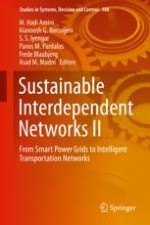This book paves the way for researchers working on the sustainable interdependent networks spread over the fields of computer science, electrical engineering, and smart infrastructures. It provides the readers with a comprehensive insight to understand an in-depth big picture of smart cities as a thorough example of interdependent large-scale networks in both theory and application aspects. The contributors specify the importance and position of the interdependent networks in the context of developing the sustainable smart cities and provide a comprehensive investigation of recently developed optimization methods for large-scale networks.
There has been an emerging concern regarding the optimal operation of power and transportation networks. In the second volume of Sustainable Interdependent Networks book, we focus on the interdependencies of these two networks, optimization methods to deal with the computational complexity of them, and their role in future smart cities. We further investigate other networks, such as communication networks, that indirectly affect the operation of power and transportation networks. Our reliance on these networks as global platforms for sustainable development has led to the need for developing novel means to deal with arising issues. The considerable scale of such networks, due to the large number of buses in smart power grids and the increasing number of electric vehicles in transportation networks, brings a large variety of computational complexity and optimization challenges. Although the independent optimization of these networks lead to locally optimum operation points, there is an exigent need to move towards obtaining the globally-optimum operation point of such networks while satisfying the constraints of each network properly.
The book is suitable for senior undergraduate students, graduate students interested in research in multidisciplinary areas related to future sustainable networks, and the researchers working in the related areas. It also covers the application of interdependent networks which makes it a perfect source of study for audience out of academia to obtain a general insight of interdependent networks.
